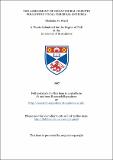Files in this item
The assessment of behavioural deficits following focal cerebral ischemia
Item metadata
| dc.contributor.advisor | Brown, Verity Joy | |
| dc.contributor.author | Ward, Nicholas M. | |
| dc.coverage.spatial | 213 p. | en_US |
| dc.date.accessioned | 2018-06-28T10:26:23Z | |
| dc.date.available | 2018-06-28T10:26:23Z | |
| dc.date.issued | 1997 | |
| dc.identifier.uri | https://hdl.handle.net/10023/14698 | |
| dc.description.abstract | Evaluating the efficacy of neuroprotective drugs in rat models of focal cerebral ischemia has involved histological and behavioural batteries to examine pathology and sensorimotor function. However, the behavioural tests used provide little insight into the nature of the neurological impairments. In an effort to gain further insight into the behavioural impairment following ischemic lesions, a battery of tasks were used. The tasks included tests of sensorimotor, motor (paw use), motivation, sensory and attentional function. The use of the potent vasoconstrictor endothelin-1 has allowed cerebral arteries to be occluded. This can be used to occlude the MCA (which is a common target of ischemia research), as well as other arteries, such as the ACA. Typically quantitative volumetric analysis has used nissl stains to assess lesion extent. However, alternative markers of tissue dysfunction are available including GFAP to assess the astroglial response to ischemia. Consequently cresyl violet and GFAP were compared along with different methods for calculating lesion volume. The boundaries of the lesion identified using the two stains corresponded closely providing care was taken when calculating lesion volume to avoid distortion from histological procedures and edema. Following MCA occlusion the rats displayed unilateral somatosensory and motor deficits, however there was no evidence of attentional dysfunction. Performance in the covert orienting task was compared with striatal dopamine depletion and with a posterior parietal cortical lesion. Neither of these manipulations resulted in deficits of covert orienting. Furthermore, the behavioural consequences of ACA occlusion were studied in two experiments using reaction time tasks designed to dissociate response impairments from dysfunction of motivation and attention. The ACA ischemic damage did not disrupt motivation or attention, however, the results were consistent with an impairment in selecting and initiating responses. | en_US |
| dc.language.iso | en | en_US |
| dc.publisher | University of St Andrews | |
| dc.subject.lcc | QP385.W2 | |
| dc.subject.lcsh | Brain--Localization of functions | en |
| dc.title | The assessment of behavioural deficits following focal cerebral ischemia | en_US |
| dc.type | Thesis | en_US |
| dc.contributor.sponsor | Medical Research Council (MRC) | en_US |
| dc.type.qualificationlevel | Doctoral | en_US |
| dc.type.qualificationname | PhD Doctor of Philosophy | en_US |
| dc.publisher.institution | The University of St Andrews | en_US |
This item appears in the following Collection(s)
Items in the St Andrews Research Repository are protected by copyright, with all rights reserved, unless otherwise indicated.

